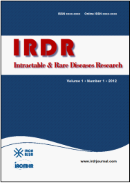Drug Discov Ther. 2023;17(4):238-247. (DOI: 10.5582/ddt.2023.01032)
Biosynthesis of copper oxide nanoparticles using Caesalpinia sappan extract: In vitro evaluation of antifungal and antibiofilm activities against Candida albicans
Sasarom M, Wanachantararak P, Chaijareenont P, Okonogi S
Synthesis of nanoparticles using natural organic substances has attracted more attention due to avoiding inorganic toxicity. This work aimed to synthesize copper oxide nanoparticles (CuONPs) using Caesalpinia sappan heartwood extract as a reducing agent. The effects of pH of synthesis reaction were investigated. The obtained CuONPs were characterized using UV-visible spectroscopy, Fourier transform infrared spectroscopy, scanning electron microscopy, and energy dispersive X-ray spectroscopy. Their particle size, size distribution, and zeta potential were determined using photon correlation spectrophotometry. Candida albicans is a major cause of chronic fungal infections due to its biofilms leading to severe drug resistance problems. In this study, in vitro antifungal and antibiofilm activities as well as killing kinetics of the synthesized CuONPs against C. albicans were investigated. Additionally, fungal biofilm was observed by using confocal laser scanning microscopy. The results showed that the pH of the synthesis reaction played an important role in the physicochemical properties and antifungal activities of the obtained CuONPs. CuONPs synthesized at pH 10 and 12 showed the relatively small and narrow size distribution with high negative zeta potential and time-dependent killing kinetics. Confocal laser scanning microscopy confirms obvious fungal biofilm reduction and increased fungal cell death after exposure to CuONPs. These findings suggest the optimal pH of CuONPs synthesis using C. sappan extract as a reducing agent. The results on antifungal and antibiofilm activities indicate that the obtained CuONPs can be a promising agent for treating fungal infection.







